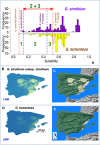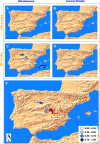Using species distribution models to locate the potential cradles of the allopolyploid Gypsophila bermejoi G. López (Caryophyllaceae)
- PMID: 32428047
- PMCID: PMC7237017
- DOI: 10.1371/journal.pone.0232736
Using species distribution models to locate the potential cradles of the allopolyploid Gypsophila bermejoi G. López (Caryophyllaceae)
Abstract
Polyploidy has been an influential force in plant evolution, playing a crucial role in diversification. Differences in polyploid and diploid distributions have been long noted, with polyploid taxa especially abundant in harsh environments. These plants have higher photosynthetic rates and/or higher tolerance to water deficits. Moreover, there is data pointing to an increase in the rate of unreduced gamete formation by plants under conditions of stress. Accordingly, a higher frequency of polyploid individuals would be expected in populations living under extreme environments, a phenomenon that may be relevant when considering the origin of allopolyploid species. Hybridization between distinct autopolyploids is known to produce allopolyploids and hence, a high frequency of compatible autopolyploids in an area could enhance the formation of stable populations of the corresponding allopolyploid hybrid. Here we consider the allopolyploid species Gypsophila bermejoi G. López and its parental taxa G. struthium L. subsp. struthium and G. tomentosa L. We have used Species Distribution Models to locate areas with low bioclimatic suitability for both parental taxa during the Last Glacial Maximum (LGM), hypothesizing that the rate of tetraploid hybrid formation would be higher than expected where low suitability areas of both parental species overlap. We selected those areas taking into account the strict gypsophyllic nature of these taxa. There is data pointing to a post-glacial origin of the current G. bermejoi populations and according to our hypothesis, such locations could be centers for hybrid tetraploid formation or potential cradles of this species. Indeed, potential Mid-Holocene cradles were also identified in this manner. The evolution of bioclimatic suitability in both LGM and Mid-Holocene cradles was studied to assess the possible survival of the hybrids, and the current distribution of G. bermejoi proved to be consistent with our hypothesis.
Conflict of interest statement
NO authors have competing interests.
Figures





Similar articles
-
Gypsophila bermejoi G. López: A possible case of speciation repressed by bioclimatic factors.PLoS One. 2018 Jan 16;13(1):e0190536. doi: 10.1371/journal.pone.0190536. eCollection 2018. PLoS One. 2018. PMID: 29338010 Free PMC article.
-
Sympatric and allopatric niche shift of endemic Gypsophila (Caryophyllaceae) taxa in the Iberian Peninsula.PLoS One. 2018 Nov 7;13(11):e0206043. doi: 10.1371/journal.pone.0206043. eCollection 2018. PLoS One. 2018. PMID: 30403709 Free PMC article.
-
Four climate change scenarios for Gypsophila bermejoi G. López (Caryophyllaceae) to address whether bioclimatic and soil suitability will overlap in the future.PLoS One. 2019 Jun 13;14(6):e0218160. doi: 10.1371/journal.pone.0218160. eCollection 2019. PLoS One. 2019. PMID: 31194783 Free PMC article.
-
Factors promoting polyploid persistence and diversification and limiting diploid speciation during the K-Pg interlude.Curr Opin Plant Biol. 2018 Apr;42:1-7. doi: 10.1016/j.pbi.2017.09.010. Epub 2017 Oct 27. Curr Opin Plant Biol. 2018. PMID: 29107221 Review.
-
Natural pathways towards polyploidy in animals: the Squalius alburnoides fish complex as a model system to study genome size and genome reorganization in polyploids.Cytogenet Genome Res. 2013;140(2-4):97-116. doi: 10.1159/000351729. Epub 2013 Jun 18. Cytogenet Genome Res. 2013. PMID: 23796598 Review.
Cited by
-
Niche shifts and localized competitive dynamics influence the persistence and distribution of polyploids in the genus Achillea (Asteraceae).Ann Bot. 2025 May 9;135(5):963-976. doi: 10.1093/aob/mcaf011. Ann Bot. 2025. PMID: 39850996
-
Occurrence Prediction of Riffle Beetles (Coleoptera: Elmidae) in a Tropical Andean Basin of Ecuador Using Species Distribution Models.Biology (Basel). 2023 Mar 20;12(3):473. doi: 10.3390/biology12030473. Biology (Basel). 2023. PMID: 36979164 Free PMC article.
References
-
- Tank DC, Eastman JM, Pennell MW, Soltis PS, Soltis DE. Progressive radiations and the pulse of angiosperm diversification. N Phytol 2015. - PubMed
MeSH terms
Substances
LinkOut - more resources
Full Text Sources

